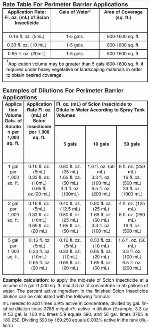Good enuf. My dissertation on nozzle selection follows, LOL. Especially in this case of ground speed = walking speed,
numerous nozzle sizes will work. The highest application rate variable is ground speed. 1mph applies double vs. 2 mph. Next is nozzle output size, .04 GPM in your case. Pressure has the least affect on output volume.
XR11004 -
XR indicates extended range regarding pressure choice. This nozzle will produce a good pattern at 15 lbs. psi up to 60 lbs. psi.. A standard nozzle operates at a narrower psi range, with 40 psi being the median. The take away is that droplets are larger/coarser at 15 psi vs. 60 psi.
Lower psi = less drift. Higher psi is needed for more atomization on hard to penetrate (thick foliage, etc.) areas, but more off-target drift prone. Like a paint sprayer, this nozzle
pattern tapers on the edges and is designed to be overlapped (even pattern nozzles are available).
110 means it has a wider, 110 degree spray pattern. You can hold it closer to the ground for less drift vs. 80 degree nozzle.
.04 means it sprays 0.4 gallons per minute at 40 lbs. pressure. More/less at different psi.
The 04 output size
is o.k., but the minimum I would use for your application. The cons of .04 is small orifice more prone to clogging. Smaller droplets more prone to drifting. It will take longer to apply vs. a larger nozzle.
I probably would have chosen an .06 for less clogging,faster application, and less drift. The .06 will have coarser droplets for less drift, especially at lower pressure, i.e., it will have the same output (1.4) at 20 lbs. as the smaller nozzle at 40 lbs., again bigger droplets less prone to drift.
You can get the job done o.k. with .04 to over .08 nozzles. Those tables above are more critical when calibrating a tractor sprayer. Practice with plain water on a given area (500 or 1,000 sq. ft,) . Again, the 1 to 5 gallons of carrier is important for even coverage on easy vs. difficult surfaces. Whether you choose 1 or 5, the most important thing is to apply the l
abeled amount of active ingredient/product. x ounces product in one gallon is the same as x ounces product in 5 gallons over the same 1,000 sq. ft.
Now, wake up, anyone that I put to sleep. Commercial Ag suppliers should have nozzles available individually.
Especially with an .04 nozzle, use one of these screens (middle) in front of the nozzle to ward of clogging:



